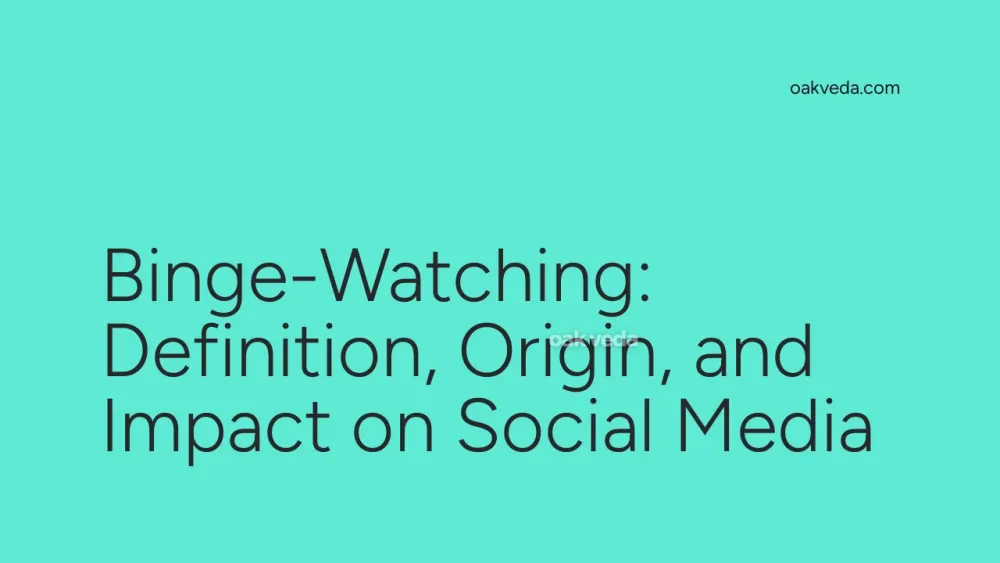
What is Binge-Watching?
Binge-watching refers to the practice of consuming multiple episodes of a TV show, series of videos, or other forms of digital content in rapid succession, typically in a single sitting. This phenomenon has become increasingly popular with the rise of streaming platforms and on-demand content, revolutionizing how people engage with entertainment media.
Origin and Development of Binge-Watching
While the concept of watching multiple episodes of a show consecutively isn't new, the term "binge-watching" gained prominence in the early 2010s. The advent of streaming services like Netflix, which began releasing entire seasons of shows at once, catalyzed this trend. This shift from traditional weekly episode releases to full-season availability marked a significant change in viewing habits.
How Binge-Watching Works
Binge-watching typically involves:
- Selecting a series or content creator
- Watching multiple episodes or videos consecutively
- Often continuing for several hours or even days
This immersive experience allows viewers to become deeply engaged with the content, characters, and storylines without interruption.
Types of Binge-Watching
Binge-watching can take various forms:
- TV Show Binging: Watching multiple episodes of a television series
- Movie Marathon: Viewing a series of related films back-to-back
- YouTube Binging: Consuming numerous videos from a particular creator or on a specific topic
- Social Media Content Binging: Scrolling through and watching multiple short-form videos on platforms like TikTok or Instagram Reels
Popular Examples of Binge-Watching
Some of the most binge-watched content includes:
- Netflix originals like "Stranger Things" and "The Crown"
- Long-running series such as "Friends" or "The Office"
- YouTube channels featuring consistent content creators
- TikTok's "For You" page, which encourages continuous scrolling and watching
Impact of Binge-Watching on Social Media Culture
Binge-watching has significantly influenced social media culture:
- Instant Gratification: Users expect immediate access to content, influencing platform algorithms and content creation strategies.
- Social Conversations: Trending topics often revolve around newly released seasons, spurring online discussions and meme creation.
- FOMO (Fear of Missing Out): The pressure to stay current with popular shows drives increased engagement.
- Content Creation: Influencers and brands create binge-worthy content series to keep audiences engaged.
Controversies Surrounding Binge-Watching
While popular, binge-watching isn't without controversy:
- Mental Health Concerns: Excessive binge-watching may lead to sleep deprivation and social isolation.
- Quality vs. Quantity: Critics argue that binge-watching may reduce the appreciation of individual episodes or videos.
- Attention Span: Some studies suggest that binge-watching might negatively impact attention spans.
How Brands and Influencers Use Binge-Watching
Brands and influencers have adapted to the binge-watching trend:
- Content Strategies: Creating series of related posts or videos to encourage continued viewing
- Storytelling: Developing narrative arcs across multiple pieces of content
- Marathons and Challenges: Hosting live streaming events or challenges that promote extended viewing
- Episodic Advertising: Crafting ad campaigns that unfold over multiple installments
Future Trends Related to Binge-Watching
The future of binge-watching may include:
- AI-Driven Recommendations: More sophisticated algorithms to suggest personalized content
- Interactive Content: Choose-your-own-adventure style series that encourage repeated viewing
- Virtual Reality: Immersive experiences that blend binge-watching with interactive environments
- Short-Form Binging: Increased focus on bite-sized, highly engaging content for quick consumption
FAQs about Binge-Watching
-
Is binge-watching bad for you? While moderate binge-watching can be enjoyable, excessive viewing may negatively impact sleep patterns and physical activity levels.
-
How has binge-watching changed content creation? Content creators now often design shows and video series with binge-watching in mind, focusing on cliffhangers and narrative arcs that span multiple episodes.
-
Can binge-watching affect social media algorithms? Yes, prolonged engagement with certain content can influence algorithms to show more similar content, potentially creating echo chambers.
-
How do streaming platforms encourage binge-watching? Platforms use auto-play features, personalized recommendations, and release entire seasons at once to promote continuous viewing.
-
What's the difference between binge-watching on traditional streaming services and social media platforms? Social media binge-watching often involves shorter-form content and more interactive elements, such as comments and shares, compared to traditional streaming.
Binge-watching has fundamentally altered how we consume and interact with digital content. As technology evolves and viewing habits continue to change, this phenomenon will likely remain a significant force in shaping social media trends and content creation strategies. Whether you're a casual viewer or a dedicated binger, understanding this trend can provide valuable insights into modern digital culture and entertainment consumption.
You may be interested in:
- Link in Bio: Definition, Origin, and Impact on Social Media
- Touch Grass: Definition, Origin, and Impact on Social Media
- ION: Definition, Origin, and Impact on Social Media
- Gen Z: Definition, Origin, and Impact on Social Media
- Vlogging: Definition, Origin, and Impact on Social Media
- DM (Direct Message): Definition, Origin, and Impact

